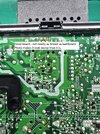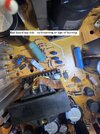Evening!
I'm trying to diagnose a CRT monitor that appears to have no power. Don't worry, I'm used to working on live voltage systems and all precautions are being taken.
Strap in....this could be a long ride as I learn!
Symptoms - No power light or control on front panel. No HV as HV is turned on by a control circuit from the signal board, but the main power circuits still need to generate the voltages to run the signal and processing board, so I believe I'm correct in thinking I don't need the signal board connected to the main board to measure and test.
I've got the schematics (see attachment). My first question is more an electronics one.
In Sheet 8 on the attachment, it shows the incoming mains and line filter board. The part I'm interested in to start with is connector CN1003 where it shows 140V (I think this is based on Japanese 100V as I'm getting 330V DC on a UK model monitor). Now this is DC as it's coming off the bridge rectifier, but then we go to the main PCB (Sheet 4 on schematics), where it comes into the board and goes to the first transformer (T1901).
Questions:
It's coming into the board as DC and appears to be arriving at the transformer T1901 as DC. I'd presume it would need to be AC for a transformer to work, otherwise it would get very hot and burn out. Am I missing something (quite obviously yes)?
The voltages coming out of the transformer are AC as expected, although one or two do not appear to be correct (7V, 2V and a wavering 4-9V). I think the 7V is prob correct, given it's going to a 6.3V or 5V rectifier.
Any advice on where to look next?
I'm trying to diagnose a CRT monitor that appears to have no power. Don't worry, I'm used to working on live voltage systems and all precautions are being taken.
Strap in....this could be a long ride as I learn!
Symptoms - No power light or control on front panel. No HV as HV is turned on by a control circuit from the signal board, but the main power circuits still need to generate the voltages to run the signal and processing board, so I believe I'm correct in thinking I don't need the signal board connected to the main board to measure and test.
I've got the schematics (see attachment). My first question is more an electronics one.
In Sheet 8 on the attachment, it shows the incoming mains and line filter board. The part I'm interested in to start with is connector CN1003 where it shows 140V (I think this is based on Japanese 100V as I'm getting 330V DC on a UK model monitor). Now this is DC as it's coming off the bridge rectifier, but then we go to the main PCB (Sheet 4 on schematics), where it comes into the board and goes to the first transformer (T1901).
Questions:
It's coming into the board as DC and appears to be arriving at the transformer T1901 as DC. I'd presume it would need to be AC for a transformer to work, otherwise it would get very hot and burn out. Am I missing something (quite obviously yes)?
The voltages coming out of the transformer are AC as expected, although one or two do not appear to be correct (7V, 2V and a wavering 4-9V). I think the 7V is prob correct, given it's going to a 6.3V or 5V rectifier.
Any advice on where to look next?



 see
see 